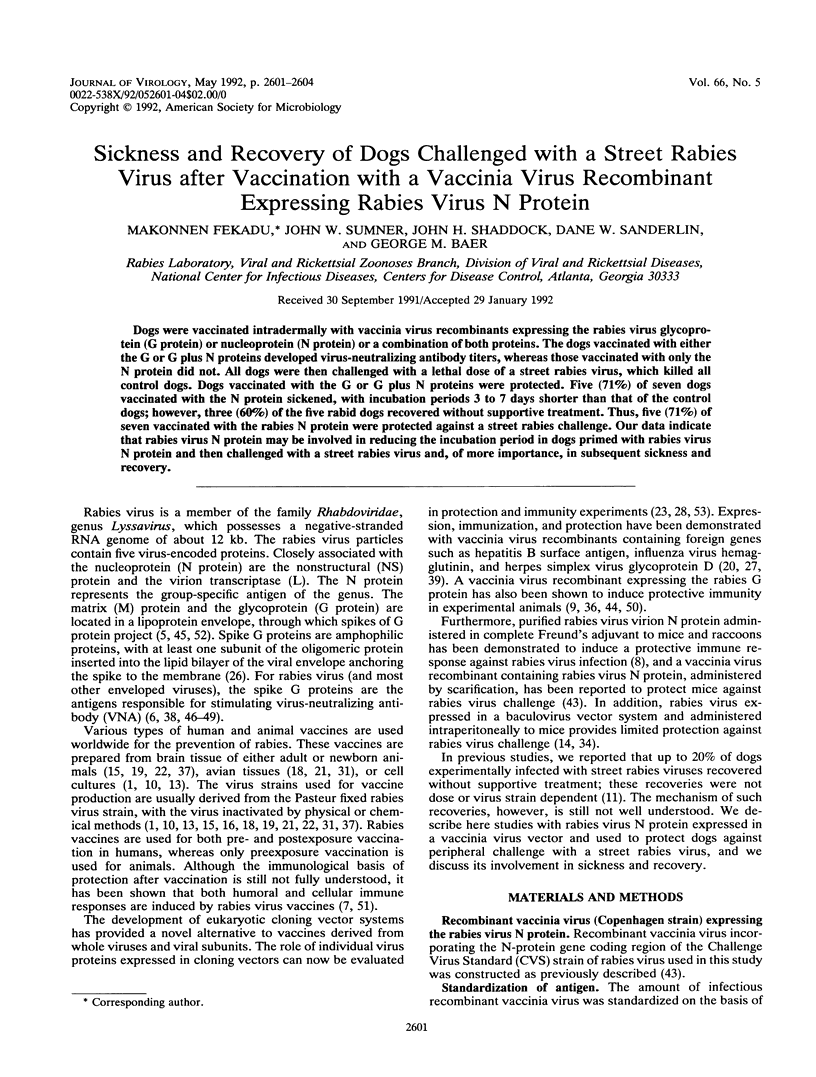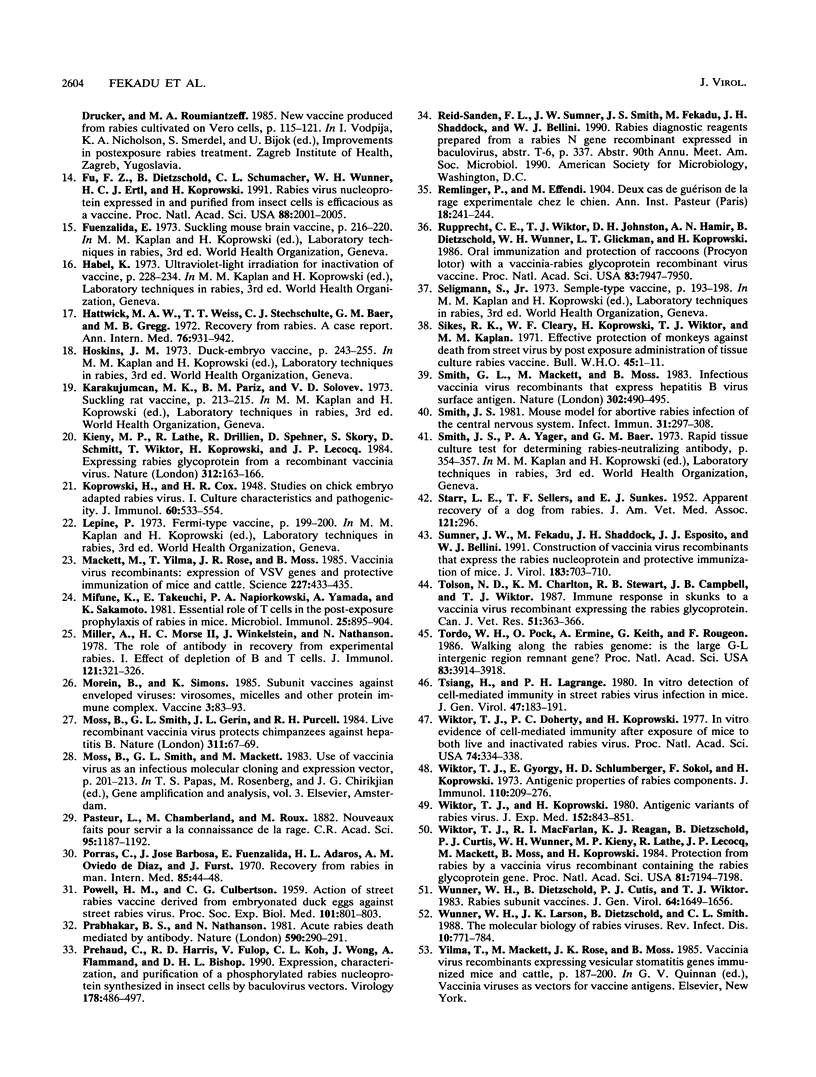Abstract
Dogs were vaccinated intradermally with vaccinia virus recombinants expressing the rabies virus glycoprotein (G protein) or nucleoprotein (N protein) or a combination of both proteins. The dogs vaccinated with either the G or G plus N proteins developed virus-neutralizing antibody titers, whereas those vaccinated with only the N protein did not. All dogs were then challenged with a lethal dose of a street rabies virus, which killed all control dogs. Dogs vaccinated with the G or G plus N proteins were protected. Five (71%) of seven dogs vaccinated with the N protein sickened, with incubation periods 3 to 7 days shorter than that of the control dogs; however, three (60%) of the five rabid dogs recovered without supportive treatment. Thus, five (71%) of seven vaccinated with the rabies N protein were protected against a street rabies challenge. Our data indicate that rabies virus N protein may be involved in reducing the incubation period in dogs primed with rabies virus N protein and then challenged with a street rabies virus and, of more importance, in subsequent sickness and recovery.
Full text
PDF



Selected References
These references are in PubMed. This may not be the complete list of references from this article.
- BELL J. F. ABORTIVE RABIES INFECTION. I. EXPERIMENTAL PRODUCTION IN WHITE MICE AND GENERAL DISCUSSION. J Infect Dis. 1964 Jun;114:249–257. doi: 10.1093/infdis/114.3.249. [DOI] [PubMed] [Google Scholar]
- Bahmanyar M., Fayaz A., Nour-Salehi S., Mohammadi M., Koprowski H. Successful protection of humans exposed to rabies infection. Postexposure treatment with the new human diploid cell rabies vaccine and antirabies serum. JAMA. 1976 Dec 13;236(24):2751–2754. [PubMed] [Google Scholar]
- Bell J. F., Lodmell D. L., Moore G. J., Raymond G. H. Brain neutralization of rabies virus to distinguish recovered animals from previously vaccinated animals. J Immunol. 1966 Dec;97(6):747–753. [PubMed] [Google Scholar]
- Cox J. H., Dietzschold B., Schneider L. G. Rabies virus glycoprotein. II. Biological and serological characterization. Infect Immun. 1977 Jun;16(3):754–759. doi: 10.1128/iai.16.3.754-759.1977. [DOI] [PMC free article] [PubMed] [Google Scholar]
- Crick J., Brown F. Viral subunits for rabies vaccination. Nature. 1969 Apr 5;222(5188):92–92. doi: 10.1038/222092a0. [DOI] [PubMed] [Google Scholar]
- Dietzschold B., Wang H. H., Rupprecht C. E., Celis E., Tollis M., Ertl H., Heber-Katz E., Koprowski H. Induction of protective immunity against rabies by immunization with rabies virus ribonucleoprotein. Proc Natl Acad Sci U S A. 1987 Dec;84(24):9165–9169. doi: 10.1073/pnas.84.24.9165. [DOI] [PMC free article] [PubMed] [Google Scholar]
- Esposito J. J., Knight J. C., Shaddock J. H., Novembre F. J., Baer G. M. Successful oral rabies vaccination of raccoons with raccoon poxvirus recombinants expressing rabies virus glycoprotein. Virology. 1988 Jul;165(1):313–316. doi: 10.1016/0042-6822(88)90692-7. [DOI] [PubMed] [Google Scholar]
- Fekadu M., Baer G. M. Recovery from clinical rabies of 2 dogs inoculated with a rabies virus strain from Ethiopia. Am J Vet Res. 1980 Oct;41(10):1632–1634. [PubMed] [Google Scholar]
- Fekadu M. Pathogenesis of rabies virus infection in dogs. Rev Infect Dis. 1988 Nov-Dec;10 (Suppl 4):S678–S683. doi: 10.1093/clinids/10.supplement_4.s678. [DOI] [PubMed] [Google Scholar]
- Fu Z. F., Dietzschold B., Schumacher C. L., Wunner W. H., Ertl H. C., Koprowski H. Rabies virus nucleoprotein expressed in and purified from insect cells is efficacious as a vaccine. Proc Natl Acad Sci U S A. 1991 Mar 1;88(5):2001–2005. doi: 10.1073/pnas.88.5.2001. [DOI] [PMC free article] [PubMed] [Google Scholar]
- Fuenzalida E. Laboratory techniques in rabies: suckling mouse brain vaccine. Monogr Ser World Health Organ. 1973;(23):216–220. [PubMed] [Google Scholar]
- Habel K. Laboratory techniques in rabies: ultraviolet-light irradiation for inactivation of vaccines. Monogr Ser World Health Organ. 1973;(23):228–234. [PubMed] [Google Scholar]
- Hattwick M. A., Weis T. T., Stechschulte C. J., Baer G. M., Gregg M. B. Recovery from rabies. A case report. Ann Intern Med. 1972 Jun;76(6):931–942. doi: 10.7326/0003-4819-76-6-931. [DOI] [PubMed] [Google Scholar]
- Hoskins J. M. Laboratory techniques in rabies: duck-embryo vaccine. Monogr Ser World Health Organ. 1973;(23):243–255. [PubMed] [Google Scholar]
- Karakujumcan M. K., Pariz B. M., Solov'ev V. D. Laboratory techniques in rabies: suckling rat brain vaccine. Monogr Ser World Health Organ. 1973;(23):213–215. [PubMed] [Google Scholar]
- Kieny M. P., Lathe R., Drillien R., Spehner D., Skory S., Schmitt D., Wiktor T., Koprowski H., Lecocq J. P. Expression of rabies virus glycoprotein from a recombinant vaccinia virus. Nature. 1984 Nov 8;312(5990):163–166. doi: 10.1038/312163a0. [DOI] [PubMed] [Google Scholar]
- Lin F. T., Chen S. B., Wang G. F., Zen F. Z., Cheng N. M., Fang J. Z. Study of the protective effect of the primary hamster kidney cell rabies vaccine. J Infect Dis. 1986 Dec;154(6):1047–1048. [PubMed] [Google Scholar]
- Lépine P. Laboratory techniques in rabies: Fermi-type vaccine. Monogr Ser World Health Organ. 1973;(23):199–200. [PubMed] [Google Scholar]
- Mackett M., Yilma T., Rose J. K., Moss B. Vaccinia virus recombinants: expression of VSV genes and protective immunization of mice and cattle. Science. 1985 Jan 25;227(4685):433–435. doi: 10.1126/science.2981435. [DOI] [PubMed] [Google Scholar]
- Mifune K., Takeuchi E., Napiorkowski P. A., Yamada A., Sakamoto K. Essential Role of T cells in the postexposure prophylaxis of rabies in mice. Microbiol Immunol. 1981;25(9):895–904. doi: 10.1111/j.1348-0421.1981.tb00094.x. [DOI] [PubMed] [Google Scholar]
- Miller A., Morse H. C., 3rd, Winkelstein J., Nathanson N. The role of antibody in recovery from experimental rabies. I. Effect of depletion of B and T cells. J Immunol. 1978 Jul;121(1):321–326. [PubMed] [Google Scholar]
- Morein B., Simons K. Subunit vaccines against enveloped viruses: virosomes, micelles and other protein complexes. Vaccine. 1985 Jun;3(2):83–93. doi: 10.1016/0264-410x(85)90055-6. [DOI] [PubMed] [Google Scholar]
- Moss B., Smith G. L., Gerin J. L., Purcell R. H. Live recombinant vaccinia virus protects chimpanzees against hepatitis B. Nature. 1984 Sep 6;311(5981):67–69. doi: 10.1038/311067a0. [DOI] [PubMed] [Google Scholar]
- Moss B., Smith G. L., Mackett M. Use of vaccinia virus as an infectious molecular cloning and expression vector. Gene Amplif Anal. 1983;3:201–213. [PubMed] [Google Scholar]
- POWELL H. M., CULBERTSON C. G. Action of rabies vaccine derived from embryonated duck eggs against street virus. Proc Soc Exp Biol Med. 1959 Aug-Sep;101:801–803. doi: 10.3181/00379727-101-25101. [DOI] [PubMed] [Google Scholar]
- Porras C., Barboza J. J., Fuenzalida E., Adaros H. L., Oviedo A. M., Furst J. Recovery from rabies in man. Ann Intern Med. 1976 Jul;85(1):44–48. doi: 10.7326/0003-4819-85-1-44. [DOI] [PubMed] [Google Scholar]
- Préhaud C., Harris R. D., Fulop V., Koh C. L., Wong J., Flamand A., Bishop D. H. Expression, characterization, and purification of a phosphorylated rabies nucleoprotein synthesized in insect cells by baculovirus vectors. Virology. 1990 Oct;178(2):486–497. doi: 10.1016/0042-6822(90)90346-s. [DOI] [PubMed] [Google Scholar]
- Rupprecht C. E., Wiktor T. J., Johnston D. H., Hamir A. N., Dietzschold B., Wunner W. H., Glickman L. T., Koprowski H. Oral immunization and protection of raccoons (Procyon lotor) with a vaccinia-rabies glycoprotein recombinant virus vaccine. Proc Natl Acad Sci U S A. 1986 Oct;83(20):7947–7950. doi: 10.1073/pnas.83.20.7947. [DOI] [PMC free article] [PubMed] [Google Scholar]
- STARR L. E., SELLERS T. F., SUNKES E. J. Apparent recovery of a dog from rabies. J Am Vet Med Assoc. 1952 Oct;121(907):296–296. [PubMed] [Google Scholar]
- Seligmann B., Jr Laboratory technics in rabies: Semple-type vaccine. Monogr Ser World Health Organ. 1973;(23):192–198. [PubMed] [Google Scholar]
- Sikes R. K., Cleary W. F., Koprowski H., Wiktor T. J., Kaplan M. M. Effective protection of monkeys against death from street virus by post-exposure administration of tissue-culture rabies vaccine. Bull World Health Organ. 1971;45(1):1–11. [PMC free article] [PubMed] [Google Scholar]
- Smith G. L., Mackett M., Moss B. Infectious vaccinia virus recombinants that express hepatitis B virus surface antigen. Nature. 1983 Apr 7;302(5908):490–495. doi: 10.1038/302490a0. [DOI] [PubMed] [Google Scholar]
- Smith J. S. Mouse model for abortive rabies infection of the central nervous system. Infect Immun. 1981 Jan;31(1):297–308. doi: 10.1128/iai.31.1.297-308.1981. [DOI] [PMC free article] [PubMed] [Google Scholar]
- Smith J. S., Yager P. A., Baer G. M. A rapid tissue culture test for determining rabies neutralizing antibody. Monogr Ser World Health Organ. 1973;(23):354–357. [PubMed] [Google Scholar]
- Sumner J. W., Fekadu M., Shaddock J. H., Esposito J. J., Bellini W. J. Protection of mice with vaccinia virus recombinants that express the rabies nucleoprotein. Virology. 1991 Aug;183(2):703–710. doi: 10.1016/0042-6822(91)90999-r. [DOI] [PubMed] [Google Scholar]
- Tolson N. D., Charlton K. M., Stewart R. B., Campbell J. B., Wiktor T. J. Immune response in skunks to a vaccinia virus recombinant expressing the rabies virus glycoprotein. Can J Vet Res. 1987 Jul;51(3):363–366. [PMC free article] [PubMed] [Google Scholar]
- Tordo N., Poch O., Ermine A., Keith G., Rougeon F. Walking along the rabies genome: is the large G-L intergenic region a remnant gene? Proc Natl Acad Sci U S A. 1986 Jun;83(11):3914–3918. doi: 10.1073/pnas.83.11.3914. [DOI] [PMC free article] [PubMed] [Google Scholar]
- Tsiang H., Lagrange P. H. In vivo detection of specific cell-mediated immunity in street rabies virus infection in mice. J Gen Virol. 1980 Mar;47(1):183–191. doi: 10.1099/0022-1317-47-1-183. [DOI] [PubMed] [Google Scholar]
- Wiktor T. J., Doherty P. C., Koprowski H. In vitro evidence of cell-mediated immunity after exposure of mice to both live and inactivated rabies virus. Proc Natl Acad Sci U S A. 1977 Jan;74(1):334–338. doi: 10.1073/pnas.74.1.334. [DOI] [PMC free article] [PubMed] [Google Scholar]
- Wiktor T. J., György E., Schlumberger D., Sokol F., Koprowski H. Antigenic properties of rabies virus components. J Immunol. 1973 Jan;110(1):269–276. [PubMed] [Google Scholar]
- Wiktor T. J., Macfarlan R. I., Reagan K. J., Dietzschold B., Curtis P. J., Wunner W. H., Kieny M. P., Lathe R., Lecocq J. P., Mackett M. Protection from rabies by a vaccinia virus recombinant containing the rabies virus glycoprotein gene. Proc Natl Acad Sci U S A. 1984 Nov;81(22):7194–7198. doi: 10.1073/pnas.81.22.7194. [DOI] [PMC free article] [PubMed] [Google Scholar]
- Wunner W. H., Dietzschold B., Curtis P. J., Wiktor T. J. Rabies subunit vaccines. J Gen Virol. 1983 Aug;64(Pt 8):1649–1656. doi: 10.1099/0022-1317-64-8-1649. [DOI] [PubMed] [Google Scholar]


